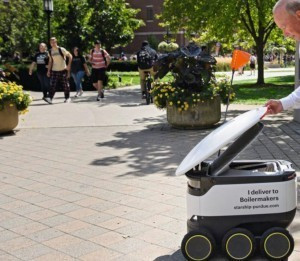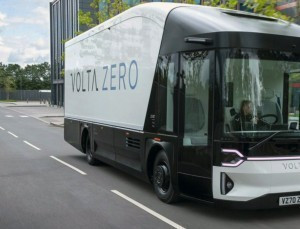After the pandemic
I write "after the pandemic", but of course it is far from over. It is hoped that a vaccine will be available by early 2021, and only then can we really think about a return to normality. But it's already clear that there have been changes in the last nine months, many of which are likely to be permanent.
 Fig. 1: A Starship Technolgies robot delivers fresh food to a customerSo, for example, shoppingin California. For many years before the pandemic, we saw a slow but steady increase in online shopping. But in the last nine months, there has been a dramatic explosion in online shopping, and most experts believe this is a permanent change. Supermarkets have hired many thousands of drivers and other staff to meet this demand. But if, for example, 40% of us now shop online, existing supermarkets will lose roughly that number of customers. In this case, the logical reaction of the supermarkets would be to downsize their premises or reallocate some of the space to another use. Many of us love Aldi and Lidl, which are also very successful in the UK. But will they change their business model in light of the changing habits I mentioned above?
Fig. 1: A Starship Technolgies robot delivers fresh food to a customerSo, for example, shoppingin California. For many years before the pandemic, we saw a slow but steady increase in online shopping. But in the last nine months, there has been a dramatic explosion in online shopping, and most experts believe this is a permanent change. Supermarkets have hired many thousands of drivers and other staff to meet this demand. But if, for example, 40% of us now shop online, existing supermarkets will lose roughly that number of customers. In this case, the logical reaction of the supermarkets would be to downsize their premises or reallocate some of the space to another use. Many of us love Aldi and Lidl, which are also very successful in the UK. But will they change their business model in light of the changing habits I mentioned above?
Currently, online orders are delivered by a man with a diesel-powered van, and that will surely change. Slowly but surely, battery-powered vans are being introduced, and as all these deliveries are local, there are no range issues. But what does the longer-term future look like? Robotic delivery vehicles, such as those offered by Starship Technologies(www.starship.xyz) and other companies(Fig. 1), are already commonplace in American and some European cities. They used to operate on relatively traffic-free college and university campuses. Originally, each robot cost around 5000 dollars, but there are plans to halve this cost. There have been arguments about whether these robots should operate on the street or on the sidewalk, but in most cities this issue has now been resolved. In the past, Amazon suggested delivering purchases by drone, but we haven't heard anything more about that in recent months. In short, the future of shopping is likely to look something like this: It won't be rosy for traditional stores, especially large department stores; not least because online shopping is simply a more cost-efficient means of delivering purchases. But shopping will definitely be less fun in the future.
During the pandemic, millions of people worked from home, and in most cases this doesn't seem to have been a problem. Workers were happy to be spared the time and expense of commuting, whether by car, train or bus. Video software such as Zoom has played a key role in this. In England today, there is a fierce debate about whether these workers should return to their offices and resume the pre-pandemic pattern or continue to work from home. In continental Europe, the vast majority of these workers are said to have returned to the traditional office. In England, only a minority have done so. Some employers have been quick to recognize that there could be benefits from smaller offices, lower rent and heating costs. The UK government, on the other hand, is encouraging employees to return to the office, mainly to support the inner city economy - sandwich bars, restaurants, dry cleaners, shoe repair shops etc.
Many economists have criticized this. If working from home is more efficient and productive, then surely it should be encouraged, as should online shopping. Others advocate a middle ground, with employees coming into the office perhaps one or two days a week to a so-called 'hot desk'.
Another question that is now being asked: If working from home saves both time and money traveling to the office, who should benefit - the employer or the employee? Some studies have suggested that employees work an extra hour a day for free. Some have suggested that if an office worker can work at home, e.g. from Planegg, instead of going to the office in Munich, why not an employee from Hungary? But the employee in Planegg can easily come to the city if needed, which is hardly possible for someone in another country.
The last example of a probably permanent change triggered by the pandemic is in the medical field. Medical practices have quickly moved to seeing patients by phone or Zoom rather than face to face. This has been criticized by some who argue that the doctor might observe something during face-to-face appointments that would not be apparent during a Zoom session. There may be some truth to this, but how this develops will be clear once we have gained more experience.
Conclusion: Covid-19 has been a major tragedy that has brought huge costs and losses. But it has also acted as a catalyst and accelerator to bring about change.
Pandemic or not - innovation never stops
 Fig. 2: Born of the 20th century: The new Ineos Grenadier SUV is not a 'green' productThisyear has been a terrible time for the automotive industry, with disastrously low sales figures. But we have seen the launch or announcement of some interesting new vehicles. Over a year ago, it was announced that production of the world famous Land Rover would cease for reasons that are not entirely clear. Then multi-billionaire Jim Ratcliffe, head of Ineos Chemicals, announced that he would build a successor, the "Ineos Grenadier" (Fig. 2).
Fig. 2: Born of the 20th century: The new Ineos Grenadier SUV is not a 'green' productThisyear has been a terrible time for the automotive industry, with disastrously low sales figures. But we have seen the launch or announcement of some interesting new vehicles. Over a year ago, it was announced that production of the world famous Land Rover would cease for reasons that are not entirely clear. Then multi-billionaire Jim Ratcliffe, head of Ineos Chemicals, announced that he would build a successor, the "Ineos Grenadier" (Fig. 2).
At first glance, it looks almost identical to the Land Rover. It will be offered with a range of BMW B57/B58 engines and a team of engineers from Magna Steyr in Graz is involved in the project. Although it has not yet been finalized, the new vehicle, which is the same size as the Mercedes G-Wagen, will most likely be built in Hambach in Alsace. It is a bold experiment to create a completely new car company and offer a vehicle that some would say is a relic of the 20th century. The "Grenadier" is certainly not "green" unless it uses biodiesel. But so far it is not clear how widely available this fuel will be worldwide.
And from France: another unorthodox car
The French have a tradition of building revolutionary and unorthodox vehicles. Think of the famous Citroën "Traction Avant" from the 1930s, the DS 19 or the Deux Chevaux. To drive the latest Citroën "Cube Car", you only need to be over 13 years old, a driver's license is optional. With the "Ami", a cube-shaped electric car that costs only around 5600 euros (Fig. 3), Citroën is targeting a very specific market, namely the inner-city mobility market. The battery-powered vehicle offers space for two people and has a range of 75 km. The top speed is 45 km/h. It is classified as a "light quadricycle", comparable to a light motorcycle (moped). The "Ami" looks almost the same from the front or rear and there are plans to offer it in various purchase and rental options, including daily rental.
 Fig. 3: Citroën's new friend, the "Ami"
Fig. 3: Citroën's new friend, the "Ami"
An electric truck
 Fig. 4: Volta's new electric truck "Zero" We know that Tesla has started production of a 40-ton, battery-powered truck with a range of 1000 km. Now Sweden's Volta Trucks is launching the world's first purpose-built 16-ton electric commercial vehicle, and analysts expect it to be well received in the market. The Volta Zero will be launched later this year, will be tested by logistics companies in the first half of 2021 and will eventually go into production in 2022. Volta Trucks, a start-up company that does most of its business in the UK, expects to sell 500 Zeros in 2022 and to reach sales of 5,000 by 2025. The Zero (Fig. 4) has a range of 150 to 200 kilometers.
Fig. 4: Volta's new electric truck "Zero" We know that Tesla has started production of a 40-ton, battery-powered truck with a range of 1000 km. Now Sweden's Volta Trucks is launching the world's first purpose-built 16-ton electric commercial vehicle, and analysts expect it to be well received in the market. The Volta Zero will be launched later this year, will be tested by logistics companies in the first half of 2021 and will eventually go into production in 2022. Volta Trucks, a start-up company that does most of its business in the UK, expects to sell 500 Zeros in 2022 and to reach sales of 5,000 by 2025. The Zero (Fig. 4) has a range of 150 to 200 kilometers.
The driver of a Volta Zero sits in a central driving position, with a much lower seat height than in a conventional truck. This combination, along with a glasshouse-style cab, provides the driver with 220-degree visibility, minimizing dangerous blind spots. The Zero will use a 160 to 200 kWh lithium iron phosphate battery. At first glance, the range seems rather modest compared to electric passenger cars, but the hub and wheel drive philosophy means it is perfectly suited to the role Volta is aiming for. Electric trucks like this will take goods from huge, centralized warehouses, deliver them to cities on fixed routes and return to the same charging station. DAF is also in the process of launching a truck, the CF Electric, with a range of 500 km per day (including a smaller recharge).
In the long term, it is predicted that these larger electric vehicles will in due course be equipped with fuel cells instead of batteries. But we now have a full range of electric vehicles, from the small Citroën "Ami" to cars, smaller vans and medium and heavy trucks. The future seems clear.
Innovation in the airspace
 Fig. 5: The projectile fuselage of the Celera 500 minimizes air resistance by promoting laminar flowAUS company has unveiled a futuristic aircraft. The projectile-shaped Celera 500 (Fig. 5) has been developed in secret for a decade and has fascinated the aviation world since it was spotted in Victorville in the Mojave High Desert in 2017. Otto Aviation says the Celera is the most fuel-efficient, commercially viable aircraft in existence. A 12-cylinder diesel engine turning a pusher propeller at the rear gives the aircraft a speed of around 700 km/h. The operating costs of 280 euros/hour are six times lower than those of similarly sized business jets. The fuel consumption of approx. 10 L/km is one eighth of that of a small jet. The shape of the six-passenger fixed-wing aircraft favors laminar flow, i.e. the oncoming air flows evenly around the fuselage and wings without the turbulence that causes drag in more conventional aircraft. Company founder Bill Otto plans to put the Celera into service in 2023. It could serve as a long-haul air cab for families or small groups, with seats that cost no more per person than a commercial flight. Unlike the slow, short-range drone-style air cabs currently being developed, the Celera will have a relatively long range and be able to fly non-stop anywhere in America. While other aircraft manufacturers favor building electric or hybrid aircraft, the Celera relies on internal combustion technology. Its German-made Red Aircraft A03 engine can burn kerosene or biodiesel and produces more than 550 horsepower. The company is planning a second model, twice the size of the 500, which could use a hybrid electric and combustion engine.
Fig. 5: The projectile fuselage of the Celera 500 minimizes air resistance by promoting laminar flowAUS company has unveiled a futuristic aircraft. The projectile-shaped Celera 500 (Fig. 5) has been developed in secret for a decade and has fascinated the aviation world since it was spotted in Victorville in the Mojave High Desert in 2017. Otto Aviation says the Celera is the most fuel-efficient, commercially viable aircraft in existence. A 12-cylinder diesel engine turning a pusher propeller at the rear gives the aircraft a speed of around 700 km/h. The operating costs of 280 euros/hour are six times lower than those of similarly sized business jets. The fuel consumption of approx. 10 L/km is one eighth of that of a small jet. The shape of the six-passenger fixed-wing aircraft favors laminar flow, i.e. the oncoming air flows evenly around the fuselage and wings without the turbulence that causes drag in more conventional aircraft. Company founder Bill Otto plans to put the Celera into service in 2023. It could serve as a long-haul air cab for families or small groups, with seats that cost no more per person than a commercial flight. Unlike the slow, short-range drone-style air cabs currently being developed, the Celera will have a relatively long range and be able to fly non-stop anywhere in America. While other aircraft manufacturers favor building electric or hybrid aircraft, the Celera relies on internal combustion technology. Its German-made Red Aircraft A03 engine can burn kerosene or biodiesel and produces more than 550 horsepower. The company is planning a second model, twice the size of the 500, which could use a hybrid electric and combustion engine.
Address of the author
Dr. Anselm T. Kuhn, c/o Metal Finishing Service Ltd, 105 Whitney Drive, Stevange, Herts,
SG14BL/England; Fax: +44/1438-906306,
E-mail:
Editor's note: The political content printed in the "Letter from England" does not necessarily reflect the views of the publisher and editors, but are the personal opinions of the author.


